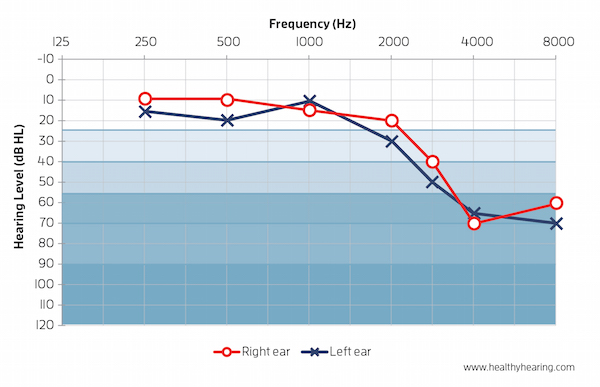[ad_1]
Contributed by Debbie Clason, staff writer, Healthy Hearing
Last updated
In simple terms, the severity of your hearing loss is measured in two ways—how loud something needs to be before you can hear it, and which frequencies are harder for you to hear (such as higher-pitched women’s voices compared to men’s voices).
As people get older, for example, it’s common to lose some hearing in the high frequencies. But hearing loss is complex and unique to each person, and it changes with time. And because even slight hearing loss is associated with cognitive decline, all hearing loss should be treated with hearing aids or other measures, regardless of a person’s age.
How sound is measured
The loudness of sound is primarily measured in units called decibels (dB). For example, here are decibel levels for some common sounds:
- Breathing: 10 dB
- Normal conversation: 40-60 dB
- Lawnmower: 90 dB
- Rock concert: 120 dB
- Gunshot: 140 dB
Prolonged exposure to sounds louder than 85 dB can cause damage to your hearing; sound at 120 dB is uncomfortable and 140 dB is the threshold of pain. This is known as noise-induced hearing loss.
The other way sound is measured is frequency, or pitch. It’s measured in Hertz (Hz). When hearing ability is tested, a range of 250 Hz to 8000 Hz is measured because it encompasses the speech frequencies, the most important range for communication.
.jpg)
Degrees of hearing loss
When measured together by your hearing healthcare professional, dB and Hz tell the degree of hearing loss you have in each ear.
- Slight hearing loss: This is when you can’t hear sounds quieter than about 15 to 20 dB, such as whispering or leaves rustling. While this is below the threshold most clinicians use to diagnose adult hearing loss, this level of hearing loss can still make listening to speech a struggle. In children, in fact, this level of hearing loss is usually treated with hearing aids to assist in speech and language development.
- Mild hearing loss: If one-on-one conversations are fine but you’re having difficulty understanding some words when there’s a lot of background noise, you may have mild hearing loss. Technically speaking, it’s defined as having hearing loss between 26 and 40 dB in the speech frequencies.
- Moderate hearing loss: At this level, you are asking people to repeat themselves a lot during conversations–in person and on the telephone. People with this degree of hearing loss cannot hear sounds lower than 40-69 dB. Both mild and moderate hearing loss can typically be treated effectively with standard hearing aids.
- Severe hearing loss: If you can’t hear people speaking without the use of a hearing aid or other amplification, or you tend to rely on reading lips to understand the conversation, you may have severe hearing loss. People with this degree of hearing loss cannot hear sound lower than 70-94 dB.
- Profound hearing loss: If you have profound hearing loss, you can only hear extremely loud conversation or sound–and even then it’s difficult to understand without a hearing aid or cochlear implant. You may prefer using sign language to communicate. People with this degree of hearing loss cannot hear sound lower than 95 dB.
How hearing loss is measured
So how do you know if you have hearing loss – and to what degree? Don’t guess or try to treat your inability to hear with over-the-counter or mail order solutions. Instead, make an appointment with a qualified hearing healthcare professional. Your family physician may be able to refer you, or you can visit our online directory and find a trusted professional in your community.

The hearing healthcare professional will administer a series of hearing tests. The outcome of the evaluation is known as an audiogram, a graph of the softest sounds you heard during your test. Here’s an example of an audiogram of someone with mild-to-moderately-severe high-frequency hearing loss. As you can see, hearing thresholds in each ear are not always the same.
Based on the outcome and the lifestyle information you provide, the hearing healthcare professional will be able to recommend a course of treatment, which may include the purchase of hearing aids and enrollment in auditory therapy classes. Keep in mind, untreated hearing loss puts you at risk for developing a host of other health-related problems, including depression, dementia and Alzheimer’s disease.
The good news? Increasingly, research is showing that hearing aids can do far more than just help you hear. They may also make you healthier. Learn more about the health benefits of hearing aids.
[ad_2]
Source link

